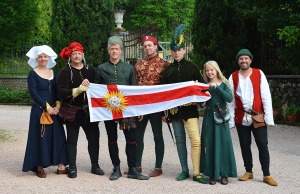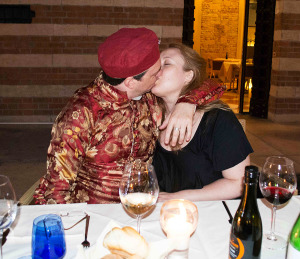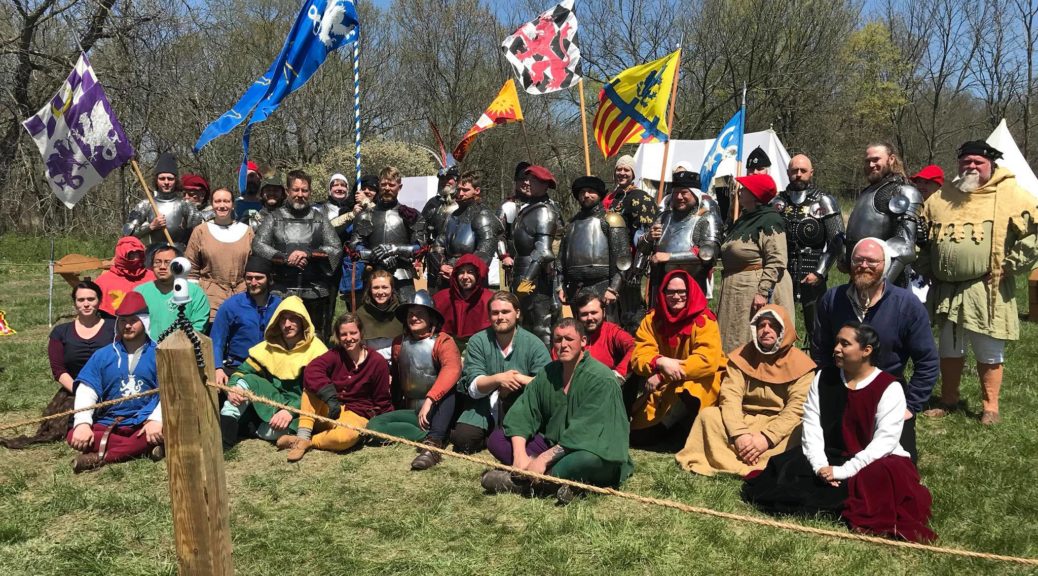‘Si regardent et enquierent et demadent ou il ait le plus honorable selon le temps en quoy ils sont.’
Geoffroi de Charny

(Sarah Watt, Marc Auger, Sean Hayes, Greg Mele, Chris Cameron, Beatrice Cameron, Jon Press)
by Christian Cameron
Some years ago, shortly after I began to study the chivalric arts (for the second time, but that’s a long story) I happened on a magnificent website for an event called ‘The Lauren Tournament.’ (http://www.laurin-tournament.com/). As soon as I had rebuilt my harness, I applied to enter the tournament… It was stunning—a full contact, well-harnessed foot tournament held in a superb setting in Italy. If you look at the pictures, you will see the sort of material culture (everything from cups to clothes)—and arms and armour—this superb event had to offer.
…And more than a year passed.
Eventually, a member of the ‘Company of the Elephant’ contacted me to say that the Laurin Tournament was no longer being held. He did mention that there was a new tournament, at Verona, called the Torneo del Cigno Bianco, or the Tournament of the White Swan. After some negotiation, both with the people who managed the Torneo and with my wife, we arranged to go to Verona in 2013, and I was able to participate in the Torneo.
All I could think, the whole time I was there, was that this—this superb event—epitomized what I wanted in Medieval reenacting. The castle itself—magnificent. The crowd—large and loud and excited and very well informed. The quality of fighting was high, the material culture amazing… I wanted to bring more of my friends to see it.
The very next weekend—still a little high from the wonder of the Torneo—I was at the Borealis WMA event hosted by Jason Smith in Ottawa/Hull here in Canada, with Sean Hayes and Greg Mele and Tasha Kelly and a host of other worthy gentlemen and ladies, and, to paraphrase Froissart, the talk turned to feats of arms and such—by which I mean that I talked everyone’s ears off about the wonders of Verona and the Torneo. My friend and sparring partner Marc Auger had already gotten the light in his eyes that meant he was going, and then, after about five minutes and some Facebook photos, Sean Hayes and Greg (who, by the way, I had only just met—and fought) were going as well.
As you may or may not know, gentle reader, I write books for a living. And what could possibly be closer to a real-life fantasy than to go abroad—to Italy—to fight in a deed of arms, with a team of companions and friends? At the same table where I met Greg Mele, I also met his lady, Tasha Kelly, who’s interest in sewing matches mine own—and she, too agreed that she would adventure to the home of Dante and Altichiero.
There then followed several months that were not at all like fantasy—negotiations with the Torneo’s excellent staff about how many knights we could bring and what events we could fight in. Perfectly reasonable—they have plenty of armoured combatants in Italy… it is considered a privilege to be invited to fight, and they do not usually accept knights who have not first fought in the ‘man-at-arms’ category. There were negotiations about styles and about rules, and about lodging… Imagine planning to attend a reenactment, and then put that reenactment on another continent.
At some point—on Facebook, the digital roll of arms… it was suggested that we also do our own, private deed or empris by fighting on one of the medieval bridges. Now, Verona is a city that reached its height of riches and fame about 1380, and had preserved it’s flavor very well—so well that as you stroll through the squares and streets, you could very easily find yourself in the fourteenth century. It boasts at least two period bridges, but one—the Ponte Castelvecchio—was built by the De La Salla tyrants of brick, a show of money and power, about 1354. (http://en.wikipedia.org/wiki/Castelvecchio_Bridge).
This led to a certain wary disbelief on the part of our noble hosts, and a lot of surreptitious planning on our part. The phrase ‘better to beg forgiveness than ask permission’ was muttered more than a few times.
Greg rented a van that would hold four armoured men.
We all bought airline tickets. That meant we were actually going.
My wife rolled her eyes a great deal. I understand Sean’s did, as well. Greg mentioned—quietly—that he planned to become engaged to Tasha during the trip. Little did we know what professional military maneuvers would be required to arrange this…
The day came, and we all embarked—from three cities across North America on at least four separate airplanes. We all had full harness. Marc and I provided the swords. Speaking only for my own efforts, I had no trouble with either harness or weapons in any airport except a small one in Greece two weeks after the torneo, and that’s another story. But point one for international armoured combatants—it is easier to move your harness in multiple bags in your luggage allowance, or ‘It takes a family to fight in Europe’ as my wife and 10 year old daughter now chorus. (Traveling knight advice #1. Pack carefully, and read baggage rules in detail. If at all possible, have a squire. Share the burden of the armour as widely as you can. ☺)
On arrival we packed ourselves into a rental car that held the three of us and my armour and weapons and yes, some actual luggage for the vacation part of the trip. We all fit, as long as none of us breathed too much. The drive from Venice to Verona was mercifully swift, and we arrived at the Corte Beatrice about 6 kilometers from Verona (and only 3 km from the torneo) to the owner’s usual superb welcome.
http://www.bedandbreakfastcortebeatrice.com/
The Corte Beatrice is not a medieval castle, but a late 17th century house of a minor noble family. However, as we lived there a week, cleaned our armour in the courtyard, practiced at the pell in Beatrice’s fields and went for runs thought the local countryside and ate the owner’s superb breakfasts—there may not be a pleasanter place to spend a week. You don’t need a tournament or deed of arms to enjoy it.
Ah—I need to mention hat we were also joined at Verona by my squire, Jon Press, of the UK, and Greg’s mum Beverly. All told, we were nine—a small reenactment group!
But I digress. Most of us practiced hard all week, by eating all the Italian food we were offered, venturing to test every local wine (the castle of Montorio, the site of the Torneo, towers over the fields of Valpolicello and Amarone) sometimes repeated tests were necessary—and driving madly from point to point to see every 14th century landmark and fresco we could collect. We spent a day together in Padua (Padova) looking at all the magnificent Altichiero our eyes could rink in, and we all went to Venice. Some went to Venice again and again… I visited Chioggia, a major scene in a book I’m writing. Altogether a great week, and while, at the outset, I knew Sean and Greg only as teachers and masters of their art, by the day of the Torneo, we were bonded as only men who have polished armour with hangovers can be bonded.
Anxious as you are for the details of the tournament, I must digress to the serious business of Greg’s engagement. Or perhaps Tasha’s engagement. According to Wikipedia an engagement is
‘During an encounter between two fencers, the point at which the fencers are close enough to join blades, or to make an effective attack. Blade contact is also referred to as an engagement, whether just standing there, during a parry, attack au fer, or prise de fer.’
And exactly like an engagement of blades, the essential element was the joining, or moment of contact.
Did I mention that Tasha loves to sew? She was creating an amazing garment for Greg—a wonderful silk doublet to wear Saturday night at the ‘feast of the knights.’ She was—very focused—on this accomplishment. (She was also doing wonderful work.) Various plans were made—and broken—as tactical errors failed to lead to the required degree of engagement. On one occasion, the two parties were both present, but the ring had failed to attend. On another, the sewing…
I expect you have the picture. Friday dawned—we all gathered for breakfast with Signora Morbioli (Beatrice) and planned our day, and Greg made one, last, desperate plan. We were all to go to the opening of the Torneo that night, in kit—and we decided that as soon as we could decently leave, we’d take Tasha into Verona, to the pre-scouted location whereat Greg would propose, blades would cross, and all would be known.

And so, like any desperate plan made by a hero in a novel, it transpired. With the support of a couple of waiters some very polite Italian tourists, and the rain holding off at just the right moment, we managed to get Greg and Tasha, alone, to the top of the magnificent stone steps…
By the way, for an alternate view of these proceedings and a lot of good 14th c. art, please read Tasha’s memoir, at http://cottesimple.com/events/verona/
Oh, very well. Eventually we all put on our armour. We armed at our Corte and drove into downtown Verona on a Saturday morning. At the bridge itself, we were met by the lovely Giulia Grigoli (you do know that Juliet of Romeo and Juliet lived in Verona—yes?) who had agreed to run interference with the ‘authorities’ if we had any problems. As she is very pretty and very charming, I expected that the Carbinieri would pay her far more attention than they would to us. We also had my excellent squire, Jon Press, from the UK, who worked to squire for us all, and my 10-year old daughter, Beatrice, who is also a fine young page and much adored by passing Italian grandmothers…
There is a video or one of both fights on the bridge somewhere on youtube (http://www.youtube.com/watch?v=SGknZZB7c_M) . I remember it as a much longer pair of fights, punctuated at hour-long intervals with moments of sharp reflection—like the moment when I saw Marc’s breastplate go flying past me, or the moment when I felt Sean’s sword move between my legs in a close play and realized that no, I was not wearing a particular form of ‘protection.’ Despite such mishaps we had two excellent passages, each fought two on two because that seemed more likely to give satisfaction to the four of us—you must keep in mind that we were concerned that we would be interrupted. Sean and Marc had a further, third encounter while Greg and I spoke through Giulia to the tourists and morning commuters…
We had a ball.
That night was the feast. Let me say, I’m a veteran reenactor of some forty years’ experience and I have never spent an entire meal so firmly in the Middle Ages.
It was as well that the four bold North American knights had trained so hard, as our Italian adversaries had decreed death—by food! Seven complete courses and a bit of roast pear later, the survivors stumbled to our feet to discover that we had one last, formidable opponent with whom to practice our arts… Grappa. Humbled, we made our way home. Someone drove. Despite which, all of us survived.
The next morning dawned. Aided by Jon, our trusty squire, the four of us armed and slipped quietly out of the Corte Beatrice (I want you to imagine how quietly four middle aged men in full harness can ‘slip’ away). We arrived at the Castle of Montorio on time—which turned out to be early by Italian standards…
An hour later we were fighting in the lists. I think I will let pictures tell the rest of the story.
We ended the day with a dinner cooked by the owner of our lodging—Signora Beatrice Morbioli, the most gracious lady, and finest cook, of the trip. We dressed her and her partner in our best spare attire and sat down in her kitchen (with Tasha, my wife Sarah and daughter Beatrice, squire Jon Press, Greg’s mother Beverly and sword master Guy Windsor and his awesome wife Michaela) to one of the best dinners of my life. Oh—did I mention I got a finger broken? Bah—it was nothing. Italian and Greek hospitals are every bit as good as ours (Traveling knight advice #2—buy travel insurance and make sure it covers you for your ‘sport.’ Mine did!)
I will close by saying that for this trip we formed the ‘Compagnia della Rose en Sole’ and our hope is to take an ‘English’ company to fight in the various tournaments—and battles—that our Italian friends offer with wonderful regularity. The Torneo Del Cigno Bianco is not their only event, but one of a cycle of tournaments and encounters and full field battles—each more splendid than the last. Nor is the Italian tournament circuit the only one in Europe, as France and Germany and Poland and the Czech Republic all offer excellent opportunities for chivalric adventure. I hope eventually to have the pleasure of an adventure in Bohemia—but for the moment, I look forward to a third return to Verona in the spring of 2015.



